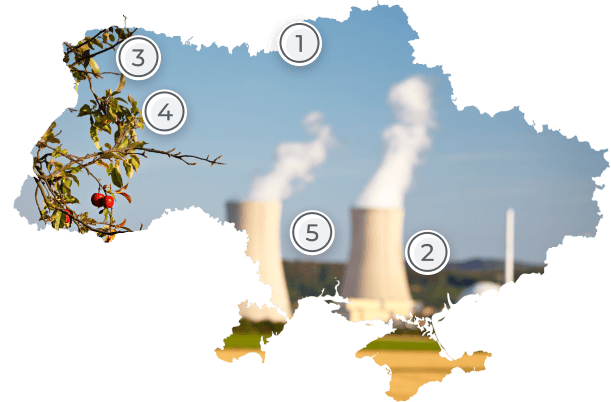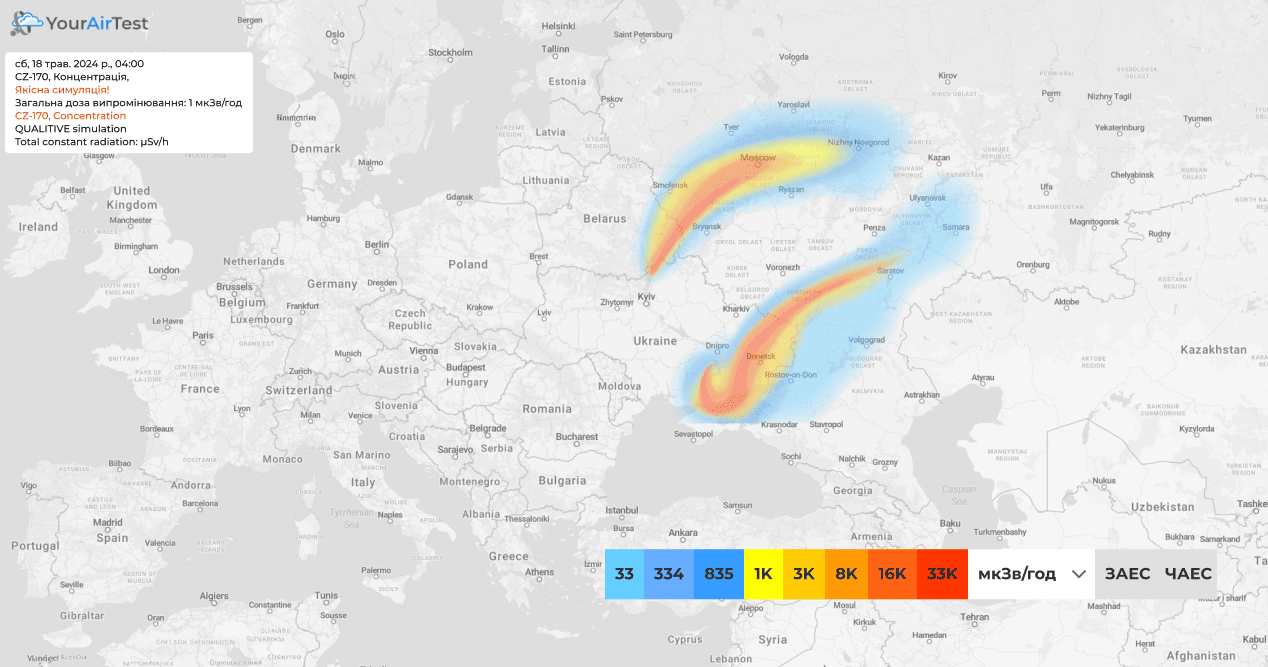In a world where preparedness and health protection are of paramount importance, YourAirTest has predicted and assessed the potential impact of accidents at five nuclear power plants in Ukraine.
We use Cesium, Cs-137 as the basis for the modeling, which is performed using Calpuff with our weather forecast generated by YAT-Meteo. Radioactivity is measured in becquerels (Bq), which reflects the number of decays per unit of time, and in microsieverts (µSv), which shows the level of radiation dose received by the human body.
This approach allows for effective risk assessment and more accurate forecasts, which is a key element for timely response and prevention of critical consequences of an accident at a nuclear power plant.


Our endeavor involves creating a predictive system to model the consequences of a missile's impact on one of the potential nuclear power reactors in Ukraine.
We've developed a service that forecasts the potential fallout for up to 48 hours. This system provides insights into the likely path of radioactive particles carried by the wind and their concentration levels. This information allows us to assess which areas might be affected and where the radiation's impact would be most severe.

Our system is capable of calculating the potential radiation level in the event of an accident, modeling the spread of radioactive substances and determining the approximate radiation level in microsieverts (µSv) for a specified single case, which allows us to assess the possible impact on the environment and public health, as well as to determine the radiation level in becquerels per second (Bq/m3)..
Radioactivity is measured in becquerels (Bq), where 1 Bq corresponds to one decay of a radioactive atom per second. This is an indicator of the activity of a radiation source, i.e. the number of decays that occur over a certain period of time.
Microsieverts (µSv), on the other hand, are used to measure the dose of radiation exposure to the body. This is a unit that takes into account not only the number of radioactive decays, but also how radiation affects living tissues. 1 sievert (Sv) corresponds to a fairly high dose, so microsieverts (1 µSv = 1/1,000,000 Sv) are used to assess health effects at low radiation levels.
Thus, becquerels (Bq) measure the activity of a radiation source, and microsieverts (µSv) measure the dose of radiation exposure to the body, which depends on the type of radiation, distance from the source, and duration of exposure.
Radiation dose indicates the degree of radiation impact on the body. This value is usually expressed in millisieverts (mSv) or microsieverts (µSv), which reflects the amount of radiation received.
Dose rate describes how much radiation a person receives over a certain period of time. The unit of measurement for dose rate is the rem per hour (Sv/h).
0.01 mSv Radiation dose during a dental X-ray
0.1 mSv Dose during a chest X-ray
2 mSv Annual dose from cosmic radiation for aviation personnel
3.2 mSv Average annual dose that a person can receive from natural sources, medical procedures, etc.
20 mSv Maximum annual dose for employees working in an environment of high radiation risk
1000 mSv Dose capable of causing symptoms of radiation sickness (e.g. fatigue or nausea) if received over a short period of time
6000 mSv Potentially fatal dose if received over a day
0.04-0.30 μSv/h Natural radiation background in most regions
0.2-0.4 μSv/h Radiation level, when exceeded, automatic monitoring systems activate a warning
5 μSv/h Dose rate during an airplane flight at an altitude of 12 km
5 μSv/h The maximum level recorded in Finland after the Chornobyl accident
10 μSv/h The level at which it is recommended to avoid unnecessary time spent outdoors
30 μSv/h The dose emitted by a patient after isotope therapy; if the dose is below this level, the patient can be discharged
100 μSv/h Safety precautions must be taken, such as moving to an enclosed area
The image shows a color scale that displays radiation levels in rem (Bq) and microsieverts per hour (µSv/h). In this system, colors correspond to different levels of radiation.
Users of the map are advised to pay attention to the color scale and correlate radiation levels with the scale indicators. If zones with elevated radiation levels are detected, it is necessary to avoid staying in these zones for a long time or to use personal protective equipment.
While we sincerely hope that such an event will never happen, we believe in the importance of modeling and understanding potential risks for the sake of our children's future. Being prepared today ensures a safer tomorrow